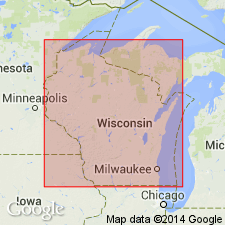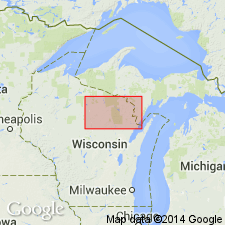
- Usage in publication:
-
- Hager rhyolite
- Modifications:
-
- First used
- Dominant lithology:
-
- Rhyolite
- AAPG geologic province:
-
- Lake Superior region
Summary:
First published use as map unit in McCaslin syncline in southeastern Forest Co, WI (south of McCaslin Mountain); western Marinette Co, WI (southeast of Thunder Mountain); and northern Oconto Co, WI (north of town of Mountain, WI), all in the Lake Superior region. Name attributed to unpublished thesis by Mancuso (Univ. of WI). Type locality not given. Derivation of name not stated. Dark and light phases recognized at field trip Stop 1. Dark phase "is characterized by large, whitish feldspar phenocrysts, inconspicuous quartz, and a lavender-grey groundmass. (Weathered surfaces are reddish...) Xenoliths of conglomerate, or other pre-existing rocks, are very scarce. Streaks of fine-grained material (schlieren?) are fairly common." Dark and light phases "appear to grade into each other through an intermediate zone about a foot wide." "The light phase is characterized by conspicuous rounded quartz phenocrysts in a pinkish groundmass." Age is not stated. Is shown on geologic sketch map (p. 3).
Source: GNU records (USGS DDS-6; Reston GNULEX).

- Usage in publication:
-
- Hager Quartz Porphyry
- Modifications:
-
- Redescribed
- Geochronologic dating
- Dominant lithology:
-
- Porphyry
- Syenite
- AAPG geologic province:
-
- Lake Superior region
Summary:
Consists of three separately mapped but apparently related lithodemic units of Wolf River batholith in central and northeastern WI, Lake Superior region. Generalized geologic map shows contacts with undifferentiated Paleozoic rocks, Belongia Granite, Peshtigo Monzonite (redescribed, revised), High Falls Granite, and Precambrian rocks older than 1,450-1,500 m.y. U-Pb concordia intercept age about 1,500 m.y. is considered most reliable age estimate of batholith. Hager Quartz Porphyry: conspicuous idiomorphic quartz phenocrysts (3-4 mm) and less prominent feldspar phenocrysts (4-5 mm) in very fine grained matrix (0.5 mm) of quartz, feldspar, and clusters of biotite and amphibole; phenocrysts (30-40 percent of rock) commonly resorbed; massive and homogeneous in outcrop without evidence of brecciation or pyroclastic activity; thus thought to be intrusive rather than extrusive. Hager Feldspar Porphyry: similar to quartz porphyry, but feldspar porphyry is darker gray and contains more abundant, conspicuous feldspar phenocrysts relative to quartz; biotite is only mafic mineral. Hager Syenite: gray to reddish gray, slightly foliated, porphyritic; has aligned phenocrysts of anhedral alkali feldspar and minor plagioclase in fine-grained matrix of feldspar, biotite, amphibole, and minor quartz; granophyric quartz and alkali feldspar intergrowths adjacent to some alkali feldspar phenocrysts. Bulk chemical analyses given. Age is Middle Proterozoic.
Source: GNU records (USGS DDS-6; Reston GNULEX).

- Usage in publication:
-
- Hager Formation*
- Modifications:
-
- Redescribed
- Revised
- Dominant lithology:
-
- Porphyry
- Rhyolite
- AAPG geologic province:
-
- Lake Superior region
Summary:
Hager Formation. Redescribed because of lithologic variations. In study area, Lake Superior region, unit divided into coeval rhyolite and quartz porphyry members. Quartz porphyry member mostly consists of 30 to 45 percent resorbed quartz phenocrysts and lesser alkali feldspar and plagioclase phenocrysts in a fine-grained equigranular matrix of quartz, two feldspars, biotite and hornblende; a variant contains more abundant feldspar phenocrysts relative to quartz and has biotite as only mafic mineral. Quartz porphyry occurs locally along southern margin of rhyolite member near Mountain, Oconto County, Wisconsin, and is probably a subvolcanic intrusion cogenetic with rhyolite member. Dikes of quartz porphyry cut Baldwin Conglomerate. Rhyolite member consists of gray to reddish-gray, slightly foliated, porphyritic rhyolite with aligned phenocrysts of anhedral alkalic feldspar and lesser plagioclase in fine-grained matrix of feldspar, biotite, amphibole and sparse quartz. Main exposures of rhyolite are along southern margin of Wolf River batholith northeast of Mountain; sporadically exposed along southside of quartzite exposed on McCaslin Mountain. Estimated areal extent of rhyolite is over 700 km. Rhyolite member originally referred to as "Hager acid extrusives" in unpublished thesis by Mancuso (1957, Univ. of WI). Various facies of Hager called "Hager granite, Hager Feldspar Porphyry and Hager Syenite" by other workers. Age is Middle Proterozoic.
Source: GNU records (USGS DDS-6; Reston GNULEX).
For more information, please contact Nancy Stamm, Geologic Names Committee Secretary.
Asterisk (*) indicates published by U.S. Geological Survey authors.
"No current usage" (†) implies that a name has been abandoned or has fallen into disuse. Former usage and, if known, replacement name given in parentheses ( ).
Slash (/) indicates name conflicts with nomenclatural guidelines (CSN, 1933; ACSN, 1961, 1970; NACSN, 1983, 2005, 2021). May be explained within brackets ([ ]).

